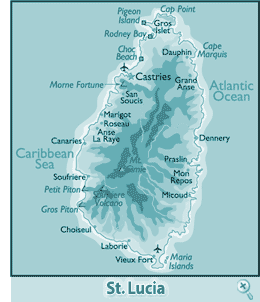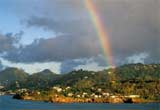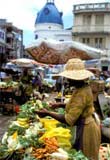
|
Official Name: Santa Lucia.
Capital: Castries.
Surface: 616 km²
Population: 160.145 inhabitants (approximate until 2002).
Language: English (official), St. Lucian Creole, French, Spanish.
Religion: Catholic, Protestant..
Currency: Eastern Caribbean Dollar.
Main Cities: Anse la Raye, Soufrière, Choiseul, Vieux Fort, Micoud, Dennery.
Country Code: 758. |
|
 St. Lucia is an independent island located in the extreme eastern part of the Caribbean Sea, of the Barlovento group in the Smaller Antilles. It is found 39 kilometers south of Martinique and around 34 kilometers northeast of St. Vincent. The island of St. Lucia is of volcanic origin like its neighboring islands and a mountain range crosses the island from north to south and it is covered by a dense tropical forest. Its highest peak is Mount Gimie (950m) and has two volcanic hills of incredible beauty to the southwest: Petit Pito and Gros Piton. St. Lucia is an independent island located in the extreme eastern part of the Caribbean Sea, of the Barlovento group in the Smaller Antilles. It is found 39 kilometers south of Martinique and around 34 kilometers northeast of St. Vincent. The island of St. Lucia is of volcanic origin like its neighboring islands and a mountain range crosses the island from north to south and it is covered by a dense tropical forest. Its highest peak is Mount Gimie (950m) and has two volcanic hills of incredible beauty to the southwest: Petit Pito and Gros Piton.
The culture in St. Lucia developed the mixture between the many ethnic groups that has participated in its history, among the memories of the years of French colonialism and the most recent British incursions. Each has brought with them beliefs, customs, religions and different traditions and all is reflected in today’s daily cultural life of the island.
Its main cities are Castries which is the capital of the island and Soufriere, Vieux Fort among others. In Castries, the Colon Square is the main center of the old section and the main historic buildings are found like the Immaculate Conception Cathedral which dates back to 1897 and is an impressive  example of colonial architecture. example of colonial architecture.
Its major tourism attractions are made up of a botanical station and the beautiful beach of Vigie. On top of Mount Fortune you can find an old fortress that dominates the city.
Soufriere is the old French capital of St. Lucia, a very peaceful villa where its population dedicate their time in fishing. French influence has made the architecture in the city very attractive in addition to it being famous for its twin peaks located in the island’s south. The Diamond Waterfalls is found in the southeast. It is called Diamond because its water changes color according to the time of the year. If you love taking a risk or love adventures, you can choose touring a volcano. There is a path that will take you directly to the crater with hot waters and natural mud that are magnificent for the skin.
Vieux Fort is the second longest port and you can also find one of the city’s airport located close to the Islas Maria Natural Reserve.
On the other hand, the city of Choiseul is the home of arts. Other attractions are the Pigeon Island National Park and its Interpretativo Museum center where you can see how the island´s culture has evolved.
The modern part of Gros Isle oriented for tourism has a large marina and is well prot ected with a variety of hotels and restaurants and the splendid Reduit Beach. ected with a variety of hotels and restaurants and the splendid Reduit Beach.
To visit Anse La Raye is a great pleasure. This small town offers services for tourists but fishing is still the main activity for the people in the region. In Marigot Bay, there is a protected marina surrounded by excellent hotels.
St. Lucia is bordered by impressive beaches that combine its freshness with untimely volcanic activity. Among the most popular are: Anse Chastanet, Anse Cochon, Toc Bay and Reduit Beach with access to luxurious hotels and restaurants with an infinite water and recreational options. There are also tennis courts, squash, golf, cricket, soccer, volleyball, basketball, table tennis, long distance races and competitions with the hotels in the region.
If you choose St. Lucia, the island will offer rest, relaxation, and youth for adults and tons of outdoor recreation for children.
|